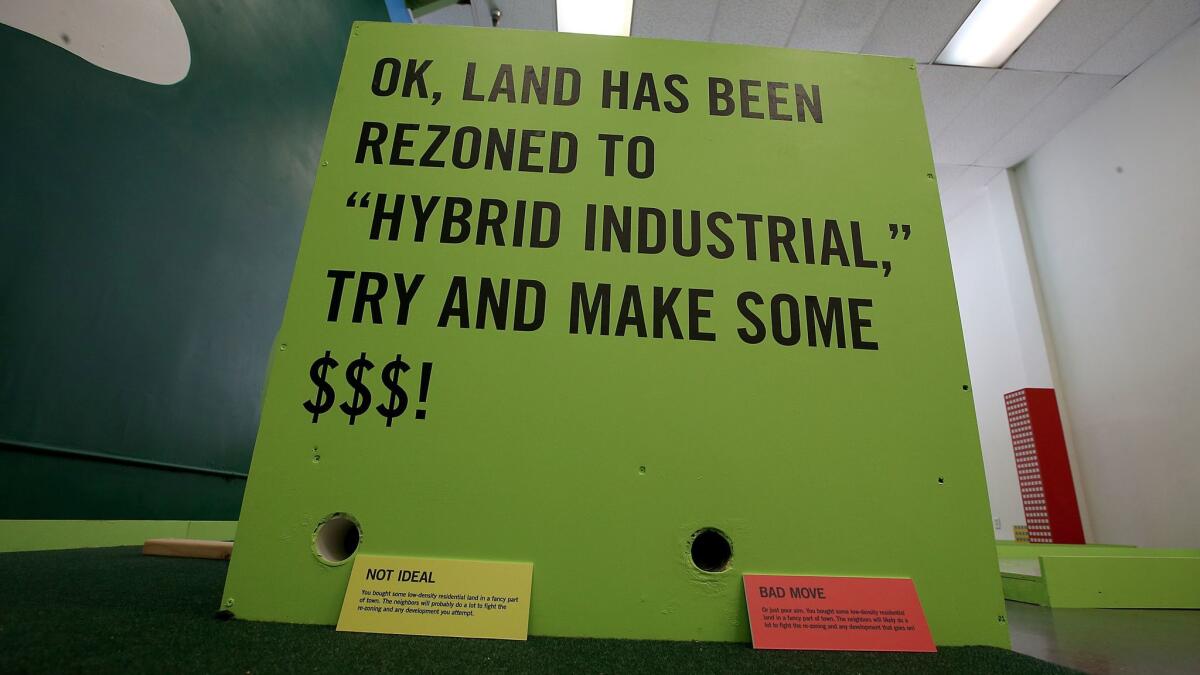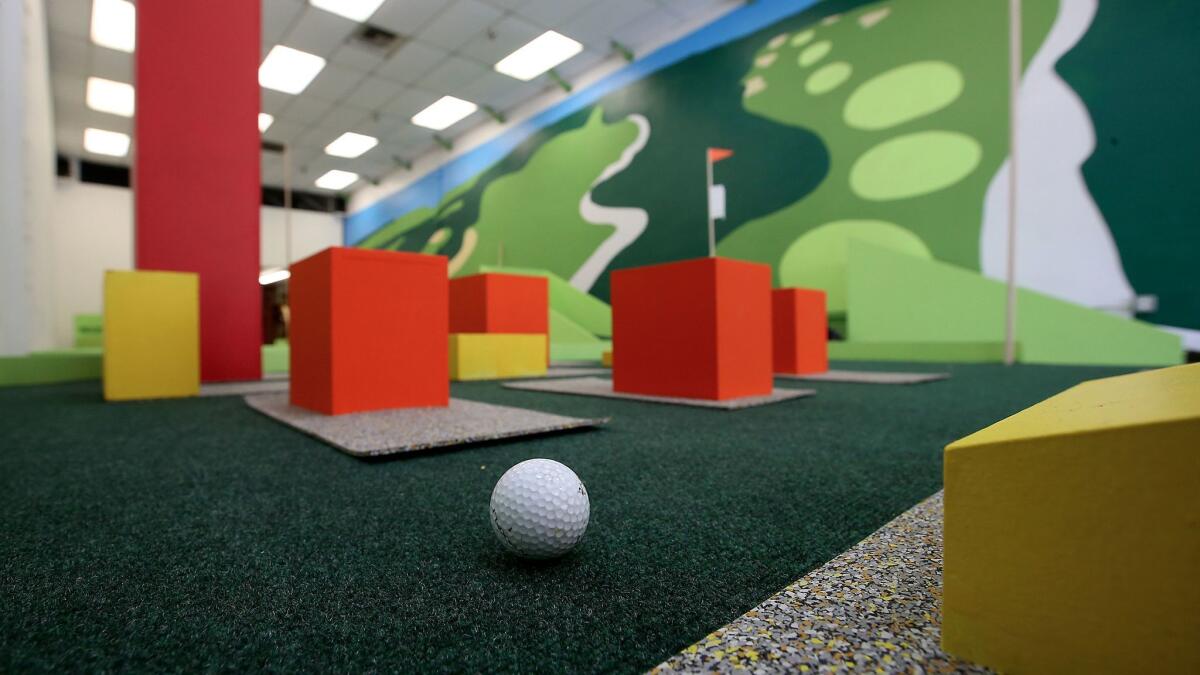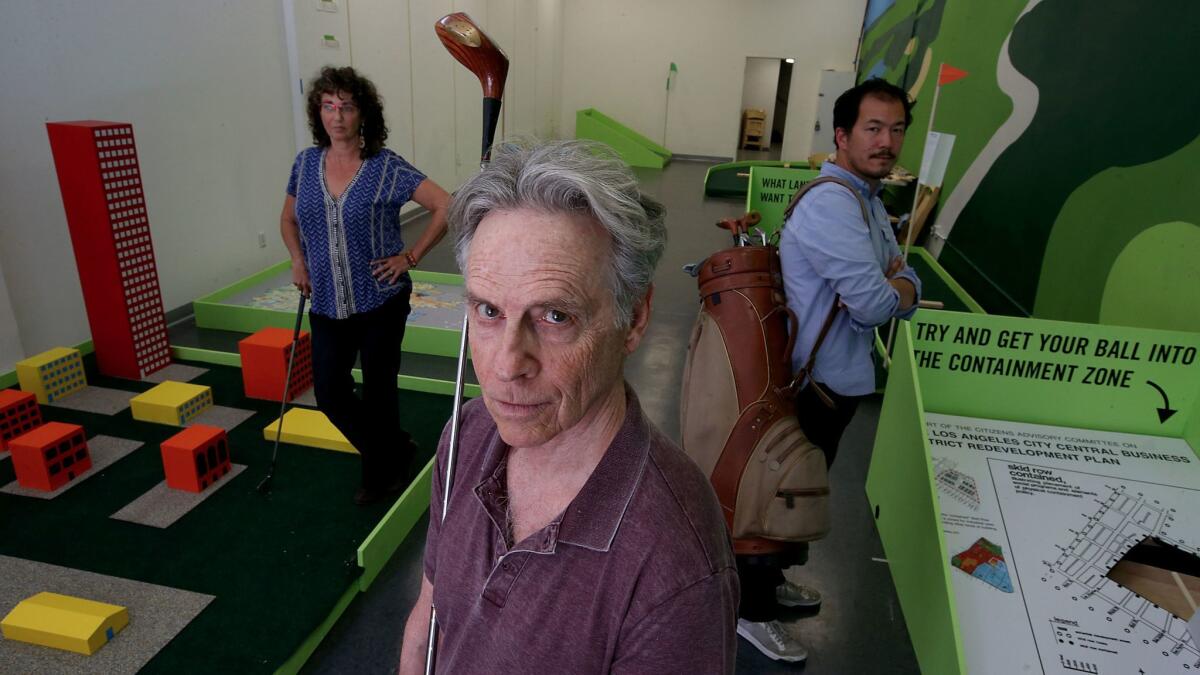An art group’s mini-golf links take on L.A. zoning, density and Trump’s Palos Verdes golf course

“The Back 9: Golf and Zoning Policy in Los Angeles,” a mini-golf course designed by artist Rosten Woo, touches on a different issue related to zoning and development.
- Share via
Sandwiched between a quinceañera dress shop and a Sbarro Italian takeout in downtown Los Angeles is a golf course. It’s certainly no Pebble Beach, but these unusual mini-golf links offer a fine opportunity to tackle challenging fairways and hone your putting — all while learning about city zoning.
Welcome to “The Back 9: Golf and Zoning Policy in Los Angeles,” a mini-golf course designed by artist Rosten Woo and the Los Angeles Poverty Department (or LAPD as it wryly refers to itself), a downtown cultural group known for staging exhibitions and theatrical events with and for members of the skid row community.
Located at the Skid Row History Museum & Archive, a narrow storefront on Broadway, each hole touches on a different issue related to zoning and development. This includes the impending rezoning of skid row, issues of density, and the ways in which powerful developers often find ways to do end runs around zoning laws.
Naturally, there is the requisite mini-golf windmill. But this one isn’t just inspired by pastoral Dutch landscape. It nods to California’s Costa-Hawkins Act, which bars rent control on single-family homes and apartments constructed after 1995.
“The back nine is a colloquial expression of a place where deals happen,” says LAPD artistic director John Malpede, seated amid golf clubs and power tools and under-construction golf obstacles featuring skyscrapers and maps of Los Angeles.
He says golf is the perfect metaphor for the clubby, behind-the-scenes deal-making that goes into urban planning in Los Angeles — “the process that happens behind the public process.”
“The Back Nine” kicks off Thursday evening with a performance inspired by golf and zoning. And, beginning Saturday, the public will be invited to play all eight holes. (The artists couldn’t quite jam nine into the storefront space.)
Golf is the perfect metaphor for the clubby, behind-the-scenes deal-making that goes into urban planning in Los Angeles.

The marriage of golf and zoning works in other ways too, says Malpede.
There’s the fact that golf has received a lot of airtime since President Donald Trump took office. Not only is he an avid golfer — he has made 23 golf trips since he was inaugurated in January — he is also the proprietor of golf courses around the world. In fact, serving as a backdrop to the LAPD’s mini-golf is a mural inspired by one of his courses.
“The whole mural is based on Palos Verdes,” says LAPD associate director Hënriette Browers, gesturing at a landscape of undulating green. “It’s taken from a promotional movie of the Trump golf course.”
Moreover, golf carries with it attendant issues of land use, which fits in nicely with zoning.
“It’s the most conspicuously egregious use of space — creating this massive, private, open space,” says Woo. “This private space, this is the place where the underlying decisions are getting made.”
“The Back Nine,” therefore, serves as a playful primer for explaining the complexities and nuances of zoning — a subject that has attained greater urgency as Los Angeles revamps its decades-old zoning code as part of an initiative called Re:Code LA.
“Zoning determines so much, but it’s so boring and so arcane,” says Woo. “If you hear someone talk about it — ”
“— you zone out,” interjects Malpede with a wicked smile.
The installation, for example, looks at the ways in which the city’s landscape could evolve under the new plans — in particular, for skid row. The neighborhood currently lies in the midst of a downtown zone that is largely industrial but which could be opened up to commercial residential development that would result in market-rate housing springing up along 4th, 5th, 6th and 7th streets.
“This is a place where homeless and formerly homeless have lived for decades and decades and decades,” says Malpede.

How the neighborhood is zoned could affect what is built there and for whom.
“We have all of this money to build affordable housing,” says Woo. “Skid Row is one of the few neighborhoods where people would welcome low-income housing. But there are people who own property in downtown and they don’t see low-income housing as part of the landscape.”
One of the mini-golf obstacles looks at skid row in the context of Los Angeles in general, while another maps what it might look like once all the rezoning is done.
Other holes — still under construction on the warm Wednesday afternoon of my visit — take on broader issues related to zoning. The second hole outlines how zoning works; the third, studded with miniature buildings of all sizes, looks at issues of bulk and density — and how density, in Los Angeles, is generally relegated to lower-income neighborhoods.
“Places like Bel-Air, these are places that are zoned to be estates,” says Woo. “So even if you bought a lot, you can’t come in and subdivide it.”
Naturally, no mini-golf on zoning would be complete without looking at the ways in which the course’s designers say developers game the system. The sixth hole was partly inspired by a Times report on the Sea Breeze development in Harbor Gateway, in which a 352-unit apartment complex in need of a zoning variance was approved by city officials who had received donations from individuals with connections to the developer.
“It’s a very hard ramp to play,” says Woo. “So you can try to play it as-is. Or you can pay the gallery attendant for a little bridge and then you can easily reach the hole.”
It’s mini-golf pay-to-play.

In addition to the golf, five theatrical performances are planned on site by actors affiliated with LAPD — most of whom hail from skid row.
The characters are based on a who’s who of downtown development, including financier Steve Mnuchin, City Councilman Jose Huizar, economic development director Jan Perry and developers Geoff Palmer and Tom Gilmore (who has been dubbed “Tom Buildmore” in the script).
There will also be an actor wielding a Donald Trump marionette who will deliver a monologue about golf, inspired by an interview about the sport that Trump gave to Fortune magazine in 2015. (Sample line: “I’ve always said about Obama that I don’t mind that he plays golf, but he should play golf with people he wants to make agreements with.”)
“I call it a ‘fictumentary,’” says Malpede of the play. “It’s inspired by real events.”
Browers says she is hopeful that they can persuade Angelenos to play a little golf and talk a little zoning.
“Steve Mnuchin, Tom Gilmore, Jan Perry, Jose Huizar,” she says. “They should all come play.”
Los Angeles Poverty Department: “The Back Nine: Golf and Zoning Policy in Los Angeles”
Where: Skid Row History Museum & Archive, 250 S. Broadway, downtown Los Angeles
When: Performances will take place on June 8, 9, 10 and 16 at 8 p.m. and June 17 at 3 p.m. The installation will be open and playable to the general public starting Saturday at 2 p.m. and will run through Oct. 28.
Info: lapovertydept.org
Sign up for our weekly Essential Arts & Culture newsletter »
ALSO:
Lowrider bikes as activist tools: General Dogon’s rolling art works are part of Skid Row history
Racism, injustice and the echo of history in the one-man internment drama ‘Hold These Truths’
A show toying with unexpected ideas of color rises at the Underground Museum
More to Read
The biggest entertainment stories
Get our big stories about Hollywood, film, television, music, arts, culture and more right in your inbox as soon as they publish.
You may occasionally receive promotional content from the Los Angeles Times.











